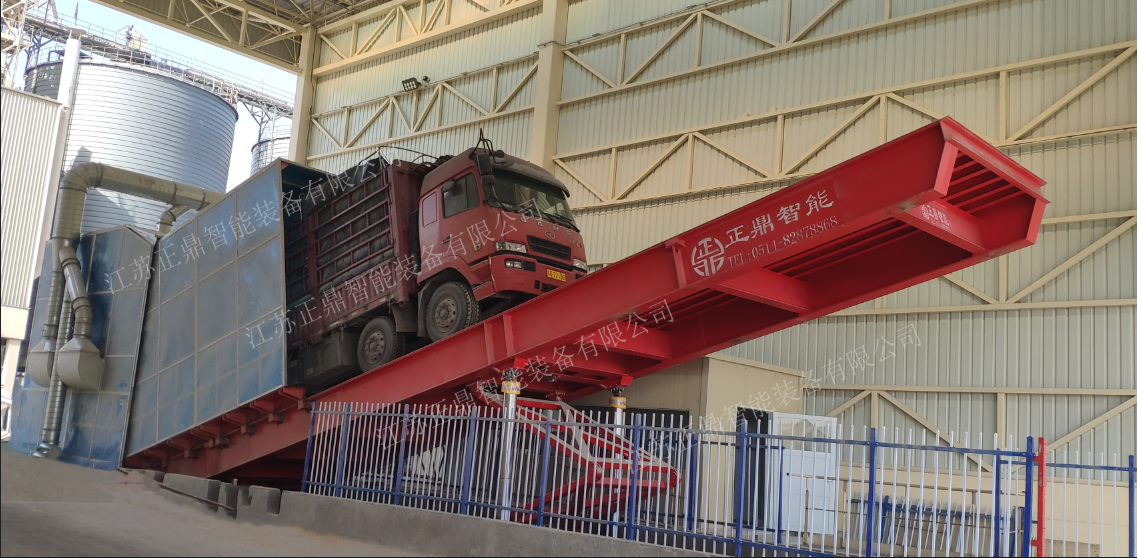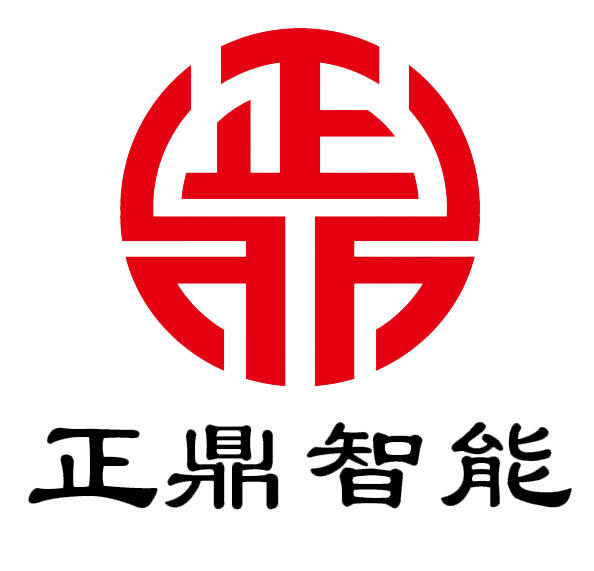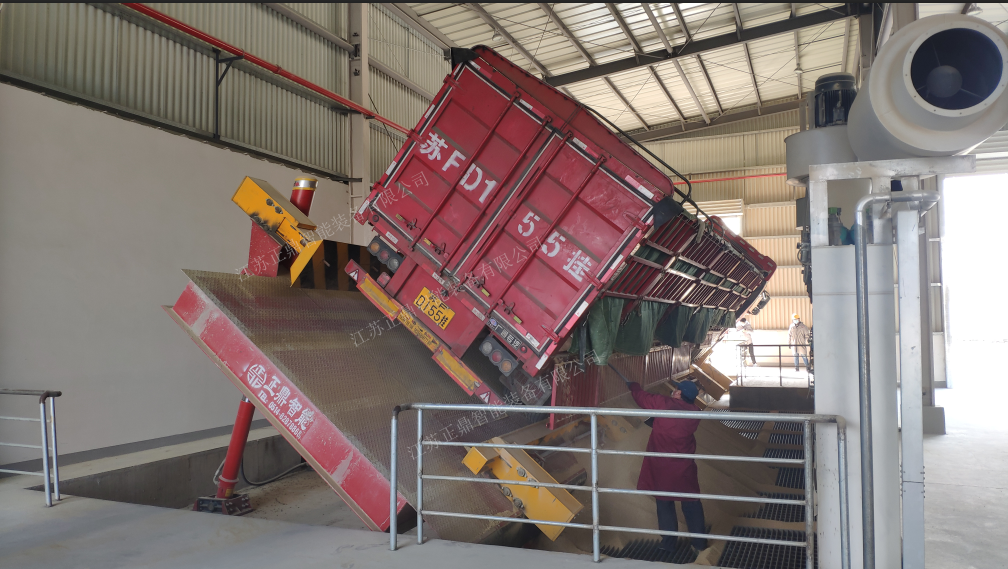첨단 컨테이너 덤퍼 기술로 대량 자재 처리 방식 혁신하기
물류 및 자재 취급 산업은 효율성을 개선하고 운영 비용을 절감해야 하는 끊임없는 압력을 받고 있습니다. 이러한 과제의 핵심에는 컨테이너 언로딩이 있으며, 이는 전체 공급망 운영을 원활하게 할 수도, 병목 현상을 일으킬 수도 있는 중요한 공정입니다. 최신 컨테이너 덤퍼 시스템은 대량 자재 취급 작업에서 전례 없는 속도와 효율성을 제공하는 획기적인 솔루션으로 등장했습니다.
기존의 컨테이너 언로딩 방법은 종종 수작업을 필요로 하며, 오랜 시간이 소요되고 상당한 안전 위험이 따릅니다. 그러나 최근의 덤퍼 시스템은 이러한 환경을 변화시키고 있으며, 기업이 더 많은 컨테이너를 처리하면서 자원 소비와 작업장 위험을 최소화할 수 있도록 해줍니다. 본 포괄적인 가이드에서는 이러한 혁신적인 시스템이 언로딩 시간을 극적으로 단축하고 운영 효율성을 향상시킬 수 있는 방법을 살펴봅니다.
최신 컨테이너 덤퍼 시스템의 핵심 구성 요소
유압 리프트 메커니즘
효율적인 컨테이너 하역의 기반은 강력한 유압 시스템에 있습니다. 현대식 덤퍼 고용량 유압 실린더를 사용하여 부드럽고 제어된 리프팅 동작을 제공합니다. 이러한 시스템은 20피트에서 40피트 컨테이너까지 다양한 하중을 처리할 수 있어 최대 중량에서도 일관된 성능을 보장합니다. 정밀하게 설계된 유압 장치를 통해 작업자는 최적의 물류 흐름을 위해 경사 각도를 조절할 수 있으며, 이는 완전한 컨테이너 하역에 소요되는 시간을 크게 단축시킵니다.
첨단 유압 시스템에는 압력 방출 밸브 및 비상 정지 장치와 같은 안전 기능도 포함되어 있어 효율성과 작업장 안전성을 모두 확보합니다. 정교한 제어 시스템을 통해 프로그래밍된 움직임 순서를 설정할 수 있어 하역 과정을 더욱 원활하게 만들어 줍니다.
자동 제어 시스템
최첨단 컨테이너 덤퍼는 지능형 제어 시스템을 갖추고 있어 언로딩 과정을 최적화합니다. 이러한 시스템은 적재 중량, 기울기 각도 및 배출 속도를 포함한 다양한 파라미터를 모니터링하며, 자동으로 작동을 조정하여 최대의 효율성을 달성합니다. PLC(프로그래머블 로직 컨트롤러) 기술의 통합을 통해 전체 컨테이너 언로딩 순서를 정밀하게 제어할 수 있어 사이클 시간을 단축하고 운영자의 개입을 최소화합니다.
현대적인 제어 인터페이스는 실시간 피드백을 제공하며, 작업자가 재료 특성 및 환경 조건에 따라 파라미터를 미세 조정할 수 있도록 합니다. 이러한 수준의 제어는 일관된 성능을 보장하면서 재료 유출이나 장비 손상의 위험을 최소화합니다.
운영 효율성 개선
효율화된 적재 절차
효율적인 컨테이너 언로딩은 최적화된 적재 절차에서 시작됩니다. 현대식 덤퍼 시스템은 컨테이너를 빠르게 위치하고 고정할 수 있도록 특별히 설계된 수신 구역을 갖추고 있습니다. 가이드 레일과 자동 잠금 장치는 정확한 정렬을 보장하여 컨테이너 설치에 소요되는 시간을 줄입니다. 이러한 시스템에는 종종 컨테이너의 올바른 배치를 확인하는 센서가 포함되어 있어 운영자가 확신을 가지고 언로딩 순서를 시작할 수 있습니다.
자동 가이드 시스템의 통합을 통해 운영자는 첫 번째 시도에서 정확하게 컨테이너를 위치시킬 수 있으므로 재배치가 필요 없어지고 전체 처리 시간이 추가로 단축됩니다. 초기 설정 단계에서의 이러한 정밀성은 보다 효율적인 언로딩 작업으로 이어집니다.
강화된 자재 흐름 관리
신속한 컨테이너 하역을 위해서는 전략적인 자재 흐름 관리가 중요합니다. 첨단 덤퍼 시스템은 자재 이동을 최적화하고 막힘을 방지하기 위해 특수하게 설계된 배출 슈트와 호퍼를 사용합니다. 이러한 구성 요소들의 형상은 도전적인 자재 조건에서도 일정한 유동 속도를 유지하도록 정밀하게 설계되었습니다.
가변 주파수 드라이브는 컨베이어 속도를 제어하여 자재 배출 속도에 맞추고 원활한 이송을 가능하게 합니다. 이러한 동기화된 작동은 병목 현상을 방지하고 하역 과정 전체에서 자재의 지속적인 흐름을 보장합니다.

안전 및 유지 보수 고려 사항
통합 안전장치
최신 컨테이너 하역 시스템은 운영자와 장비를 보호하는 포괄적인 안전 기능을 갖추고 있으며, 효율성 저하 없이 안전성을 제공합니다. 안전 연동 장치는 모든 고정 장치가 올바르게 작동하지 않으면 작동을 차단합니다. 근접 센서는 잠재적 장애물이나 위험을 감지하여 필요한 경우 자동으로 작동을 중지시킵니다.
비상 정지 시스템은 빠른 접근이 가능하도록 전략적으로 배치되어 있으며, 작동 중에 안전 장벽이 자동으로 작동합니다. 이러한 기능들은 최적의 하역 속도를 유지하면서 동시에 안전한 운영 환경을 조성하는 데 함께 작용합니다.
예방적 유지보수 프로토콜
컨테이너 하역 작업에서 최고 성능을 유지하려면 체계적인 예방 정비가 필요합니다. 현대의 덤퍼 시스템에는 주요 성능 지표를 추적하고 운영에 영향을 줄 수 있는 문제를 조기에 경고하는 정교한 모니터링 시스템이 포함되어 있습니다. 정기 정비 일정은 실제 사용 패턴과 시스템 성능 데이터를 기반으로 최적화됩니다.
예지 정비 기술은 센서를 사용하여 부품 마모와 환경 조건을 모니터링함으로써 정비 팀이 계획된 가동 중지 시간 동안 점검을 수행할 수 있도록 합니다. 이러한 능동적 접근 방식은 예기치 못한 지연을 최소화하고 일관된 하역 성능을 보장합니다.
컨테이нер 하역 기술의 미래 트렌드
IoT 통합 및 데이터 분석
컨테이너 언로딩의 미래는 사물인터넷(IoT) 기술을 활용하는 스마트하고 연결된 시스템에 있습니다. 이러한 시스템은 운영 데이터를 수집하고 분석하여 패턴과 최적화 기회를 식별합니다. 실시간 모니터링을 통해 조건 변화에 즉각 대응할 수 있으며, 과거 데이터 분석을 통해 언로딩 절차의 지속적인 개선이 가능합니다.
고급 분석 기술을 활용하면 시설에서 컨테이너 언로딩 일정을 최적화하고, 유지보수 필요 시점을 예측하며 운영에 영향을 미치기 전에 병목 현상을 파악할 수 있습니다. 이러한 데이터 기반 접근 방식은 점점 더 효율적인 언로딩 프로세스로 이어집니다.
자동화 및 로봇
자동화 및 로봇 공학 분야의 신기술은 컨테이너 언로딩 작업을 더욱 혁신할 전망입니다. 무인 운반 차량(AGV)은 인간의 개입 없이도 컨테이너를 정확한 위치에 배치할 수 있으며, 로봇 시스템은 고정 및 모니터링 작업을 지원합니다. 이러한 발전은 언로딩 시간을 단축함과 동시에 안전성과 신뢰성을 향상시킬 것으로 기대됩니다.
인공지능의 통합을 통해 시스템이 경험에서 학습하고, 재료 특성 및 환경 조건에 기반하여 최적의 성능을 위해 자동으로 매개변수를 조정할 수 있게 될 것입니다.
자주 묻는 질문
현대적인 컨테이너 덤퍼 시스템을 사용할 경우 평균적으로 얼마나 시간이 단축되나요?
현대적인 컨테이너 덤퍼 시스템은 전통적인 방법에 비해 일반적으로 적재 해제 시간을 40-60% 단축시킵니다. 이러한 효율성 향상은 자동화된 프로세스, 최적화된 자재 흐름 및 수작업 개입 필요성 감소에서 비롯됩니다.
기상 조건이 컨테이너 적재 해제 효율성에 어떤 영향을 미치나요?
기상 조건이 컨테이너 적재 해제 작업에 영향을 미칠 수는 있지만, 현대 시스템은 다양한 조건에서도 효과적으로 작동하도록 설계되어 있습니다. 고급 센서와 제어 시스템이 최적의 성능을 유지하도록 매개변수를 조정하지만, 극한의 날씨에서는 추가적인 예방 조치가 필요할 수 있습니다.
컨테이너 덤퍼 시스템에 권장되는 정비 주기는 어떻게 되나요?
일반적인 유지보수 일정에는 매일 실시하는 시각 점검, 주간 시스템 점검 및 월간 종합 유지보수가 포함됩니다. 그러나 예지 정비 기능을 갖춘 현대식 시스템의 경우 실제 사용 패턴과 부품 마모 지표를 기반으로 일정을 맞춤화할 수 있습니다.
시설에서 고급 컨테이너 하역 시스템에 투자하는 것을 어떻게 정당화할 수 있나요?
투자 수익은 일반적으로 인건비 절감, 처리량 증가, 안전 기록 개선 및 유지보수 비용 감소를 통해 이루어집니다. 대부분의 시설은 운영 효율성 향상과 다운타임 감소를 통해 18~24개월 이내에 투자 회수를 완료합니다.

